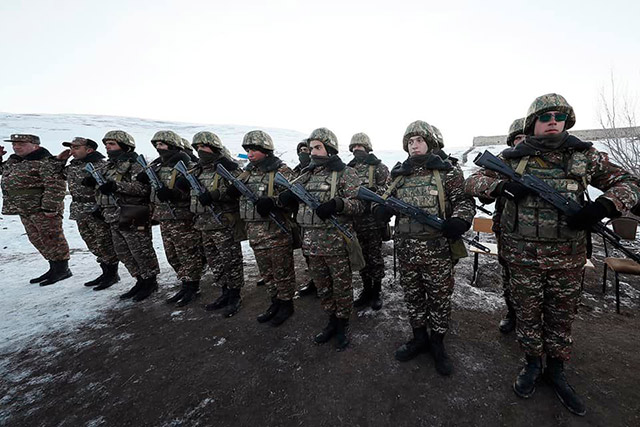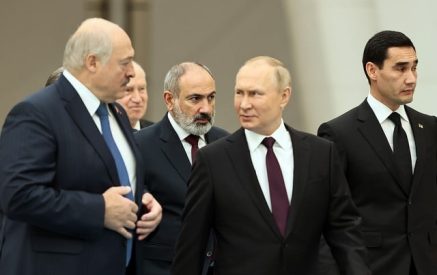The post-war year in Armenia was marked by ongoing challenges in domestic and geopolitics. The nation faced renewed threats as Azerbaijan launched attacks along its eastern border. Armenian and Azerbaijani leadership met for negotiations on issues including demarcation and delimitation of the international border, the unblocking of regional transport and communication links, and the release of Armenian prisoners of war, with little progress. In the realm of domestic politics, the government of Armenia held extraordinary parliamentary elections under the pressure of an opposition movement demanding the prime minister’s resignation. As the nation enters the new year, the futures of Armenia and Artsakh remain uncertain.
The surrender of seven territories outlying Artsakh, including Zangelan, Qubatlu and Kelbajar, to Azerbaijan as a result of the 2020 Artsakh War created a new eastern border with Azerbaijan. Security threats quickly arose due to the close proximity of Armenian civilians to Azerbaijani soldiers stationed along the border. Residents of border communities have reported cross-border fire and restricted access to farmland. Azerbaijani soldiers have also placed national flags and signposts along the 21 kilometer stretch of the Kapan-Meghri highway ceded to Azerbaijan after the end of the war.
While the war between Armenia and Azerbaijan ended on November 9, 2020, incursions by Azerbaijani soldiers onto sovereign Armenian land have ignited renewed fighting. Since May 2021, hundreds of Azerbaijani soldiers have been illegally stationed within the eastern border of Armenia. On May 12, approximately 250 Azerbaijani soldiers advanced upon Sev Lich (Black Lake) in the Syunik province and border sections of the Gegharkunik province. Since then, at least 14 Armenian soldiers have been reported dead in intermittent border attacks on Armenian positions near Yeraskh along the border with the Nakhichevan Autonomous Republic and along the Gegharkunik border. Two Armenian civilians in Artsakh have also been reported killed by Azerbaijani fire.
Read also
The deadliest outbreak of fighting took place in mid-November after Azerbaijan launched an attack along the eastern border of Armenia on November 16. At least 13 soldiers were killed on both sides in five hours of fighting that ended with a Russian-brokered ceasefire. The attacks followed several days of escalated tensions. On November 12, Azerbaijani border guards set up checkpoints along the Goris-Kapan highway, isolating border communities in Syunik.
Amid the border tensions, international actors including the Russian Federation and the European Council have mediated dialogue between Armenian and Azerbaijani leaders. On January 11 in Moscow, Armenian PM Nikol Pashinyan, Azerbaijani President Ilham Aliyev and Russian President Vladimir Putin signed their second trilateral statement, following the November 9 ceasefire agreement. The agreement created a commission to oversee the unblocking of regional and transport communication links. The ceasefire agreement stipulates that Armenia must provide transport routes to allow for the movement of passengers and goods between Azerbaijan and Nakhichevan. On January 11, the leaders also agreed to provide Armenia railway access to Iran and Russia.
The working group temporarily suspended its activities for several months in response to the Azerbaijani invasion in May. Indeed, since the start of 2021, Aliyev has repeatedly threatened to use force to create a land passage through Syunik without passport or customs controls, which he terms the “Zangezur corridor.”
On May 19, a draft statement was leaked stating that Pashinyan, Aliyev and Putin had agreed to create a joint commission for demarcation and delimitation of the Armenia-Azerbaijan international border. Pashinyan said that he was prepared to sign the agreement if Azerbaijan withdrew its soldiers from Armenian territory. Such an agreement was never signed. A trilateral meeting to discuss demarcation and delimitation as well as the opening of regional economic channels had been proposed for the anniversary of the ceasefire agreement on November 9, 2021. Yet the meeting was postponed over a disagreement regarding corridors.
The meeting finally took place on November 26 in Sochi, arranged by Putin following the November border clashes. The leaders agreed to “push the process of establishment of a bilateral commission with the advisory participation of the Russian Federation” on border delimitation and demarcation, which Putin said would be created by the end of 2021. On December 14 Pashinyan and Aliyev met in Brussels by mediation of European Council President Charles Michel. The leaders agreed to “proceed with the restoration of railway lines, with appropriate arrangements for border customs and controls, based on the principle of reciprocity.” On the morning of the meeting, Aliyev told reporters that the “Zangezur corridor” should operate similarly to the Lachin corridor connecting Armenia and Artsakh protected by Russian peacekeepers.
No agreements regarding the creation of a commission on border demarcation or delimitation or the restoration of transport and communication links have been announced.
Armenia and Azerbaijan have also failed to reach a final agreement on humanitarian issues such as the exchange of POWs. The ceasefire agreement orders the exchange of all POWs and other detained persons. While Azerbaijan has released over 100 Armenian POWs since the end of the war, Armenian authorities say up to 107 Armenians remain in Azerbaijani captivity.
On March 17, Human Rights Watch published a report documenting evidence of illegal torture and killing of Armenian civilian captives held in Azerbaijan. In September, a report published by the office of the Ombudsman of Armenia and the Yerevan-based International and Comparative Law Center compiled evidence of physical and psychological torture of Armenian POWs and deprivation of adequate food, water, sleep and medical attention, with no distinction between the treatment of detained combatants and civilians by Azerbaijani officials and military personnel.
Despite international calls for the repatriation of all Armenian POWs, Azerbaijan only admits to the detention of 62 POWs, captured during an incursion in the southern region of Hadrut in Artsakh one month after the end of the war. The soldiers have been charged in Baku courts with crimes of terrorism and illegal crossing of the state border to justify their continued detention.
The previous year was also marked by ongoing turmoil in domestic politics. The Homeland Salvation Movement was formed after the war to call for the formation of an interim government of national unity that would organize snap elections. The opposition movement, which included the Armenian Revolutionary Federation (ARF), organized demonstrations for several months to demand the resignation of PM Pashinyan, who they blamed for the defeat in the war. On February 25, the military brass of the country signed a joint statement joining the opposition’s calls for Pashinyan’s removal, after he announced the creation of a working group to lead reforms of Armenian Armed Forces.
In March, Pashinyan announced that snap elections would take place on June 20, based on an agreement with the two opposition parliamentary factions, the Prosperous Armenia and Bright Armenia parties. Pashinyan formally resigned in late April while continuing to carry out his duties as acting PM, and the National Assembly dissolved in early May to trigger the extraordinary parliamentary elections.
A total of 22 political parties and four alliances participated in the election. Pashinyan’s Civil Contract Party won a decisive victory and renewed its parliamentary majority with 54-percent of the vote. The Armenia Alliance, led by former president Robert Kocharyan and consisting of the ARF and the Resurgent Armenia Party, became the largest parliamentary opposition with 21-percent of the vote. The I Have Honor Alliance led by former president Serge Sargsyan also secured its spot in parliament with five-percent of the vote. The elections were regarded as free and fair yet marred by polarization and inflammatory rhetoric among candidates.























































